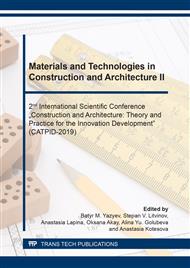[1]
H.F.W. Taylor, Cement Chemistry, Academic Press, London, (1990).
Google Scholar
[2]
V.V. Timashev, Selected Works Synthesis and hydration of binding materials,, Nauka, Moscow, (1986).
Google Scholar
[3]
A.P. Osokin, Y.R. Krivoborodov and E.N. Potapova, Modified Portland cement, Strojizdat, Мoscow, (1993).
Google Scholar
[4]
I.V. Kravchenko, M.T. Vlasov and B.E. Yudovich, High-strength and especially fast-hardening cements, Strojizdat, Мoscow, (1971).
Google Scholar
[5]
W. Kurdowski, Chemia cementu i betonu, Wydawnictwo Naukowe PWN, Warszawa, (2010).
Google Scholar
[6]
B.V. Gusev, Yu.R. Krivoborodov and S.V. Samchenko, Technology Portland cement and its varieties, NRU MGSU, Moscow, (2016).
Google Scholar
[7]
S.V. Samchenko, Formation and genesis of the structure of cement stone, Moscow: Moscow State University of Civil Engineering, IP Media, DAS, DIA, 2016. Information on http://www.iprbookshop.ru/49874.
Google Scholar
[8]
Yu.A. Belentsov, The relationship of the structure of cement stone with its basic structural properties, Cement and its application. 1 (2007) 86-87.
Google Scholar
[9]
A.M. Dmitriev, T.V. Kuznetsova, B.E. Yudovicha and et al, Hydration doping of cements with bents, in: Abstracts of reports at the VI All-Union Scientific and Technical Conference on Cement Chemistry and Technology, Moscow: VNIIESM. (1982) 94–98.
Google Scholar
[10]
E.N. Potapova, Y.R. Krivoborodov, T.V. Kouznetsova and S.V. Samchenko, Usage of zeolite and volcanic tuffs at cement production, in: 16th International multidisciplinary scientific geoconference. (2016) 887-894.
DOI: 10.1051/matecconf/201710603026
Google Scholar
[11]
S.S. Kaprielov, A.V. Sheinfeld and Yu.R. Krivoborodov, Influence of the structure of cement stone with additives of silica fume and superplasticizer on the properties of concrete, Concrete and reinforced concrete. 7 (1992) 4-5.
DOI: 10.1201/9781482296631-24
Google Scholar
[12]
M.S. Mansour, M.T. Abadla, R. Jauberthie and I. Messaoudene, Metakaolin as a pozzolan for high performance mortar, Cement- Wapno- Beton. 2 (2012) 102-108.
Google Scholar
[13]
M. Antoni, J. Rossen, F. Martirena and K. Scrivener, Cement substitution by a combination of metakaolin and limestone, Cement and Concrete Research. 6 (42) (2012) 1579-1589.
DOI: 10.1016/j.cemconres.2012.09.006
Google Scholar
[14]
Yu. R. Krivoborodov, I. Yu. Burlov and A.Yu. Burlov, The use of secondary resources for cement, Building materials. 2 (2009) 44-45.
Google Scholar
[15]
Mateusz Radlinski and Jan Olek, Investigation into the synergistic effects in ternary cementitious systems containing Portland cement, fly ash and silica fume, Cement & Concrete Composites. 34 (2012) 451–459.
DOI: 10.1016/j.cemconcomp.2011.11.014
Google Scholar
[16]
L.M. Sulimenko, Yu.R. Krivoborodov, V.V. Plotnikov and N.I. Shalunenko, Mechanical Activation of Binding Compositions Based on Technogenic Products, Proceedings of Higher Educational Institutions – Construction. 10 (1998) 51-56.
Google Scholar
[17]
V.V. Plotnikov V.V and Yu.R. Krivoborodov, The effect of activating nanostructures on the synthesis and quality of clinker, Dry building mixes. 6 (2010) 34-36.
Google Scholar
[18]
E. Potapova, Y. Krivoborodov, S. Samchenko and T. Kouznetsova, Effective ecological building materials based on activated ash-cement mixtures, Proc. SGEM. 26 (18) (2018) 149-156.
Google Scholar
[19]
S. Samchenko, I. Kozlova and O. Zemskova, Use of industrial waste in the production of foam concrete based on slag Portland cement, Proc. SGEM. 26 (18) (2018) 451-458.
DOI: 10.5593/sgem2018/6.3/s26.057
Google Scholar
[20]
S.V. Samchenko and E.M. Makarov, Modification of macro- and microstructure of composite materials with calcium silicate, Technique and technology of silicates. 4 (2013) 20-24.
Google Scholar
[21]
V.I. Loganina and K.V. Zhegera, Formation of the strength of the cement composition in the presence of synthesized aluminosilicates, Bulletin of the South Ural State University. Series: Building and Architecture. 2. (15) (2015) 43-46.
Google Scholar


